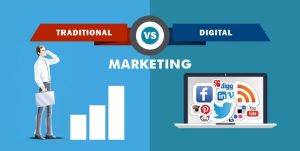
Introduction
in the case of Difference Between Digital Marketing and Traditional Marketing, In century evolving business world, the choice digital marketing and traditional marketing can impact a business success. As a digital marketer, it’s crucial to increase business profits and business stand the fundamental differences between these two approaches and understand their respective importance in driving business growth.
What is the digital marketing?
the Digital marketing is the digital channels to promote products or services, connect with target audiences, and drive desired actions. It a wide range of tactics, including search engine optimization (SEO), social media marketing, email marketing, content marketing, and pay-per-click (PPC) advertising. With its ability to reach consumers across various online platforms, digital marketing has become indispensable for businesses looking to thrive in the digital world.
What is the traditional marketing?
Traditional marketing refers to conventional methods of promoting products or services through offline channels. These channels include print media (newspapers, magazines), broadcast media (TV, radio), direct mail, outdoor advertising (billboards, posters). Traditional marketing has been the cornerstone of advertising for century, using on mass media to reach broad audiences. traditional marketing still plays a significant role in many marketing strategies, particularly for reaching certain demographics or local business.
Difference Between Digital Marketing and Traditional Marketing
According to the Difference Between Digital Marketing and Traditional Marketing , the Digital marketing uses online tools like SEO, social media, email, content, and PPC ads to connect with people. It reaches audiences through websites, social platforms, search engines, and apps, driving engagement. Traditional marketing, on the other hand, uses offline methods like print, TV, radio, mail, and outdoor ads. While traditional tactics can work in some situations, they’re often not as precise or measurable as digital strategies. Overall, the shift to digital marketing reflects how people prefer to interact today. By focusing on digital and using data to guide decisions, businesses can grow their visibility and grow in the digital century.
features of digital marketing
- Global Reach: Digital marketing allows businesses to reach a global audience.
- Targeted Advertising: It enables precise targeting of specific demographics, interests, and behaviors, improving the effectiveness of marketing efforts.
- Measurable Results: Digital marketing offers various tools and metrics for tracking and analyzing campaign performance in real-time, providing valuable insights for optimization.
- Cost-Effectiveness: Compared to traditional marketing channels, digital marketing often offers lower costs and higher returns on investment.
- Personalization: Digital marketing allows for personalized communication and content tailored to individual preferences, enhancing customer engagement and satisfaction.
features of traditional marketing
- Tangible Materials: Traditional marketing relies on physical materials such as flyers, brochures, posters, and billboards to convey messages to the audience.
- Local Targeting: Traditional marketing methods can focus on specific geographical areas, allowing businesses to target local audiences effectively.
- Face-to-Face Interaction: Events, trade shows, and in-person demonstrations enable direct interaction between marketers and potential customers, fostering personal connections.
- Mass Audience Reach: Traditional marketing channels like television, radio, and print media have the potential to reach a large audience simultaneously.
- Brand Visibility: Billboards, signage, and physical storefronts contribute to brand visibility and recognition within local communities.
how to apply digital marketing in business?
- Set Clear Goals: Define specific, measurable goals for your digital marketing efforts, such as increasing website traffic, generating leads, or improving brand awareness.
- Know Your Audience: Conduct market research to understand your target audience’s demographics, preferences, and online behavior to tailor your digital marketing strategies effectively.
- Create a Strong Online Presence: Develop a professional website and establish a presence on relevant digital platforms such as social media, search engines, and online directories.
- Content Marketing: Create valuable, relevant content such as blog posts, videos, infographics, and podcasts to attract and engage your target audience.
- Search Engine Optimization (SEO): Optimize your website and content to improve search engine rankings and visibility, driving organic traffic to your site.
conclusion
In conclusion, the primary difference between digital marketing and traditional marketing lies in their approach, channels, and audience engagement. Digital marketing leverages online platforms, targeting specific audiences with personalized content, offering real-time analytics and interactivity. In contrast, traditional marketing relies on offline channels such as print, television, and radio, reaching broader audiences with less targeted messaging and limited measurability. While traditional marketing offers tangibility and local reach, digital marketing provides global reach, precise targeting, and cost-effectiveness. Ultimately, the choice between digital and traditional marketing depends on business objectives, audience preferences, and budget considerations in today’s dynamic marketing landscape.

